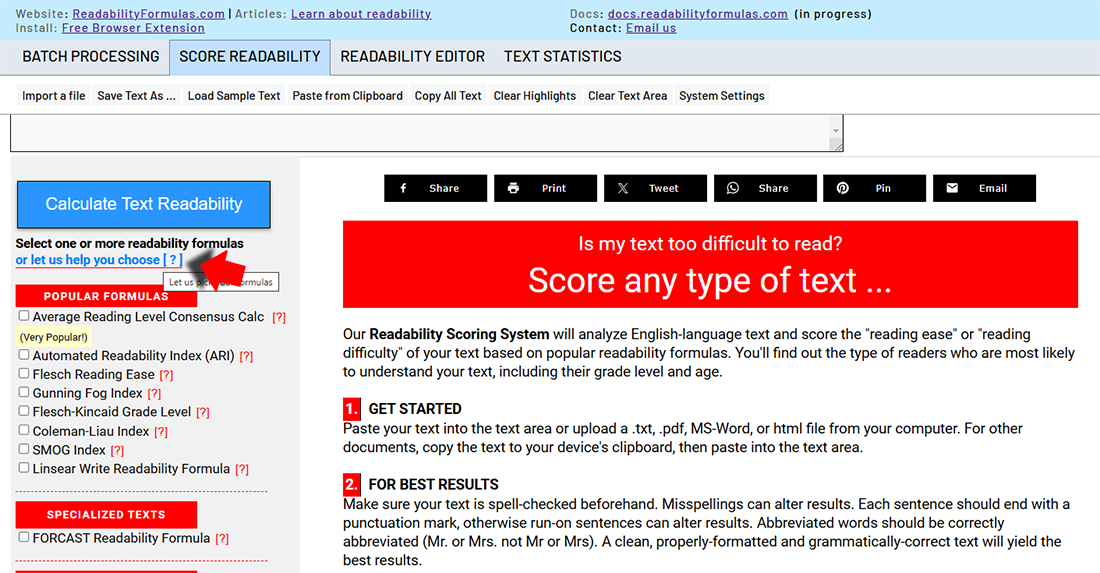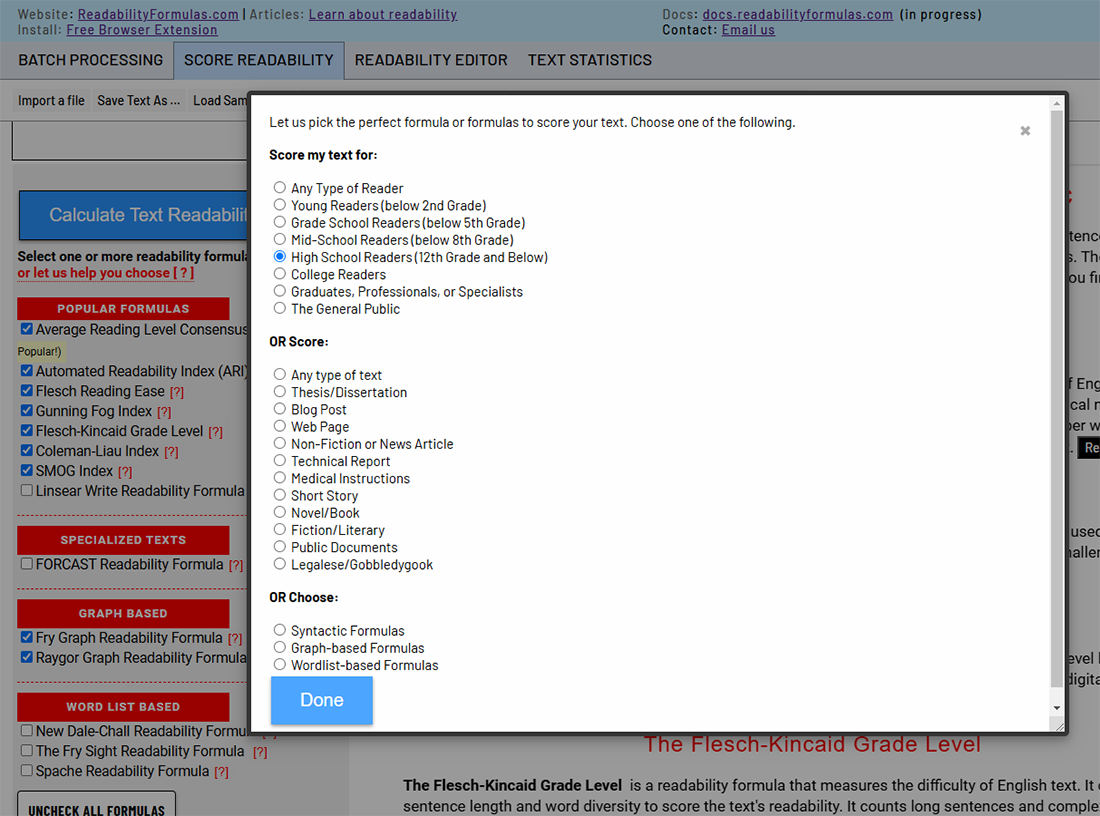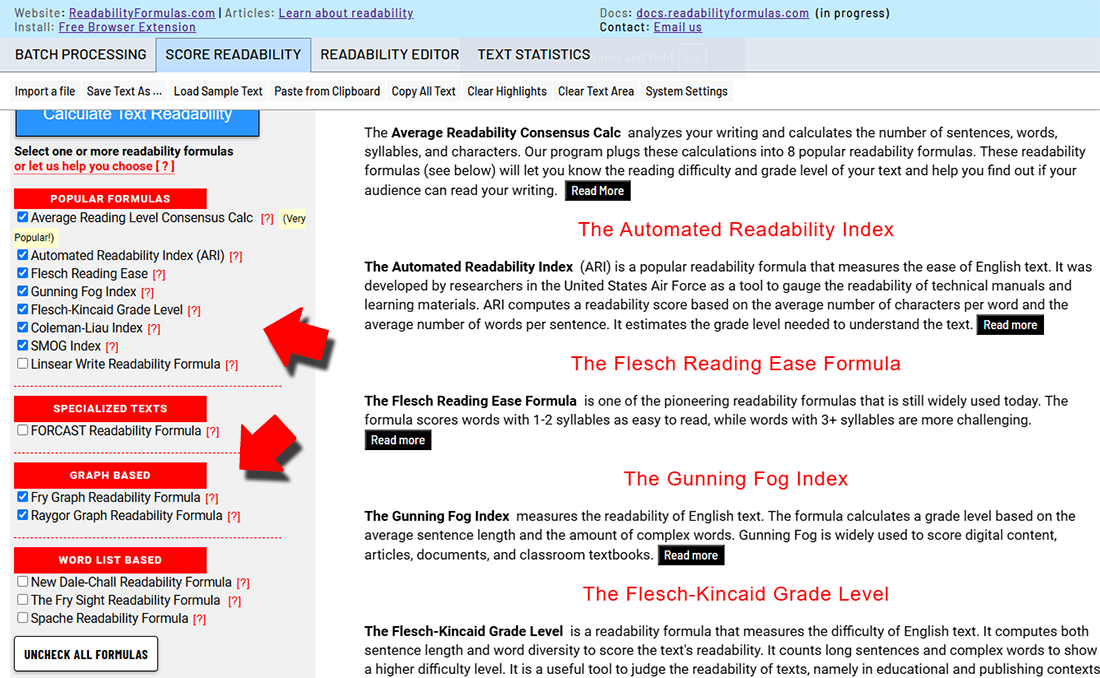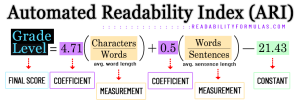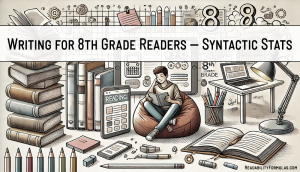Imagine you’re browsing through a bookstore, and you come across a fascinating book. You open it eagerly, only to face dense paragraphs, complex sentences, and jargon. You’re more puzzled than informed. This experience is common. It highlights a critical aspect of writing that often goes overlooked: readability.
Readability formulas are the silent arbiters of communication—they can determine if a text invites readers in or shuts them out. They can help transform a perplexing manuscript into an inviting conversation with the reader. In a world where attention is the most coveted currency, creating an accessible document is not just about courtesy; it’s about connection.
How easy a text is to read and understand matters profoundly—whether it’s a student trying to grasp new concepts, a patient deciphering medical advice, or a professional staying abreast of industry trends. Since the 1940s, scholars have developed hundreds of readability formulas, each with its unique strengths and applications. However, the question stands: out of today’s arsenal, which readability formula—or combination—should you use to help edit your documents to perfection?
First, Know Your Audience!
Let’s step into the shoes of Rachel, a seasoned science teacher who’s passionate about igniting curiosity in her students. She’s spent the weekend drafting an article on the wonders of the solar system. She hopes to distill her knowledge into young minds. Before she prints a stack of copies, Rachel pauses—a question flickers in her mind. Will her words resonate with the eager yet novice astronomers in her 6th-grade class?
Rachel’s challenge underscores a pivotal element of writing often encountered yet seldom addressed—the reader’s lens. Her students, bright-eyed and bushy-tailed, aren’t versed in the dense astronomical jargon that peppers academic papers. They need simplicity, a touch of wonder, and language that bridges galaxies to their world. Like Rachel, every writer must navigate this path. Each one must tailor their message to inform, connect, and be understood.
The digital age compounds this challenge. A blogger, for example, vying for attention in the vast ocean of online content, must ensure their words are not only SEO-friendly but also clear and captivating at a glance.
As we unravel the tapestry of readability formulas, picture the faces of your readers like Rachel does. Will your words quench their thirst for knowledge or leave them adrift in confusion? Choosing the correct readability formula (or formulas) is more than an academic exercise—it’s a key that unlocks the potential of your text to educate, engage, and enlighten.
Use this table to decide which formula is best for what you’re writing:
Readability Formulas Comparison
| Formula | Suitable for | Measures | Factors |
| Dale-Chall Readability Formula | General audience | Word familiarity | Uses a list of familiar words to assess difficulty |
| Fry Sight Formula | Young readers and general audience | Word familiarity and sentence length | Uses unfamiliar words and sentence length to assess readability levels |
| Spache Readability Formula | Primary school texts | Word frequency and sentence length | Good for lower grade levels |
| SMOG Readability Formula | General business documents | Grammar, syntax, and word choice | Incorporates grammatical difficulty |
| Flesch Reading Ease | Wide range including educational materials | Sentence length and word syllables | Produces a score correlating with reading ease |
| Gunning Fog Index | Business and professional texts | Word complexity and sentence length | Ideal for analyzing upper secondary education materials |
| Fry Graph | Educational materials and documents | Sentence and syllable count per 100 words | Visual tool for assessing readability |
| Coleman-Liau Readability Formula | Grade level scoring | Character count | Focuses on characters rather than syllables for ease estimation |
| McAlpine EFLAW | English as a Foreign Language | Word familiarity and structure | Designed for non-native English speakers |
| Automated Readability Index (ARI) | General audience | Characters per word and words per sentence | Provides a grade level score for readability |
| Flesch-Kincaid | Wide range including military documents | Sentence length and syllable count | Commonly used in the United States education system |
| FORCAST | Military and technical manuals | Monosyllabic word frequency | Designed for non-narrative materials |
| Linsear Write | English texts for non-native speakers | Sentence and word length | Simple calculation method |
| Raygor Estimate Graph | Wide range including textbooks | Sentence length and word count | Provides a visual readability estimate |
(Learn more about each formula in our HELP section)
EDUCATION
The role of the education sector is to distill good education to students at different grade levels. Written text in the form of textbooks, journals, literature and so on, builds the backbone of a good education system. Educational consultant Jennifer Gonzalez says, “It’s essential to make content accessible. If students can’t process the material, then we’ve failed to truly educate.” An effective education system depends on clear, well-written materials that readers find challenging but not too difficult.
1. Dale-Chall Readability Formula scores all types of texts for any grade level. It’s renowned for its “list of familiar words” approach, which can measure how easily readers can understand the text. Research shows that aligning texts with readers’ language skills can improve comprehension by up to 50%.
2. The Fry Sight Readability Formula scores text based on unfamiliar words and sentence length, making it useful for young readers and general audiences.
3. For younger readers, the Spache Readability Formula is an excellent choice. Applied to materials for students up to the 4th-grade level, it has been shown to simplify word complexity and sentence structure effectively. Early childhood expert Dr. Seema Raina notes that “simplifying language for early readers can enhance reading fluency for beginners by approximately 40%.”
4. The SMOG Formula targets readers from the 4th grade to college. G. Harry McLaughlin developed this formula to highlight the complexity in their texts. Students exposed to grade-appropriate texts improve their reading skills by 35% over time ( Literacy Research and Instruction ).
5. The Flesch Reading Ease uses sentence length and word syllables to score text readability. One study suggested that “readers understand texts with higher Flesch scores by as much as 65% than lower-scoring texts” ( Journal of Applied Psychology ).
6. For professional materials, the Gunning Fog Index ensures that texts strike the right balance between “reading ease” and “reading difficulty.” It looks at sentence length and word complexity. Reader engagement can increase by 20% more if your text uses simpler and clearer words, according to business writer David Silverman .
7. The Fry Graph’s visual analysis can score all types of texts for all grade levels.
8. The Coleman-Liau Readability Formula is for 4th-grade through college-level texts. It’s a modern formula that uses letter counting.
9. Lastly, the McAlpine EFLAW aids in assessing texts for ESL/EFL students. Research shows that ESL learners reading texts at their readability level have a 75% faster retention rate for new vocabulary (TESOL Journal).
HEALTH CARE INDUSTRY
Imagine a busy doctor in a bustling city hospital, handing a stack of pamphlets about managing diabetes to a patient. This patient, a retired teacher, faces the daunting task of understanding her new diagnosis and its management. The pamphlets are filled with complex medical jargon and dense text that seem more intimidating than informative. It’s a scene that plays out daily in healthcare settings across the globe—the challenge of bridging the gap between medical knowledge and patient understanding. In such scenarios, the importance of readability cannot be overstated.
The Health Care Industry is a prolific producer of literature that caters to a diverse spectrum of stakeholders: patients who seek to understand their health conditions; healthcare practitioners updating their knowledge; pharmacists explaining medication usage; and researchers sharing breakthroughs. The clarity of information is important. Choose one or more formulas to help edit and refine such materials.
1. Dale-Chall Readability Formula: the Dale-Chall formula can help simplify medical information so diverse readers, including patients with limited health literacy, can understand what they’re reading.
2. Flesch Reading Ease: This formula can help improve patient education materials, such as healthcare pamphlets.
3. Fry Graph: Use the Fry Graph to score healthcare materials, especially patient-facing medical instructions.
4. Gunning Fog Index: FOG can score healthcare business publications, and help the writer convey medical concepts more clearly to professionals.
5. FORCAST: can help score healthcare forms, administrative instructions, and healthcare procedures.
6. Raygor Estimate Graph: Dr. Lisa Walker , a healthcare communication expert, says, “The Raygor Graph is versatile, making it suitable for many types of healthcare documents, from research papers to patient pamphlets.”
These formulas serve as valuable tools—they can enhance the effectiveness of healthcare communications.
MILITARY AND GOVERNMENT
In the heat of a crisis, misunderstanding a military manual can result in life or death. A group of recruits faced this reality during a training exercise in a remote desert location. The operation was risky, and the equipment was complex. As the recruits grappled with the machinery, they tried following the instructions. Unfortunately, the manual was dense, filled with technical jargon, and not user-friendly. Their confusion led to missteps. In a real combat scenario, this could have had severe consequences. This incident was a catalyst for change, prompting military and governmental agencies to prioritize the readability of their manuals.
1. Automated Readability Index (ARI): Using ARI on instructional manuals can reduce user errors and improve training efficiency ( Journal of Military Communication ).
2. Flesch Reading Ease: Documents with improved Reading Ease scores can better engage readers by as much as 30% more ( Government Communication Review ).
3. Flesch-Kincaid: Tailored for manuals, forms, and technical documents, the Flesch-Kincaid can help writers present complex military and governmental instructions with clarity.
4. FORCAST: FORCAST is the formula of choice for scoring technical manuals, multiple-choice quizzes, applications, and entrance forms used in military and government.
5. Linsear Write: Linsear Write is suited for advanced texts to ensure critical information is easily digestible.
PUBLISHING
In the dynamic world of publishing, where the tastes and reading levels of audiences can vary as much as the genres on the shelves, publishers ensure their books engage and resonate with readers. To bridge the gap between prose and reader, the industry uses readability formulas to score the difficulty of manuscripts.
1. Dale-Chall Readability Formula: Publishing editor Sarah Williams highlights, “Dale-Chall is a versatile tool that helps authors create accessible content across various genres.”
2. Fry Sight Readability Formula: This formula ensures texts are accessible yet challenging by evaluating sentence length and unfamiliar words. It useful for reaching low-level readers and ensuring age-matching complexity.
3. Flesch Reading Ease: Dr. James Miller , a publishing industry veteran, emphasizes, “Flesch formula is a go-to tool for scoring readability in diverse publishing formats.”
4. Fry Graph: A recent analysis revealed that books with simplified text complexity, guided by the Fry Graph, saw a 25% increase in reader engagement ( Book Industry Report ).
5. Spache: this formula is indispensable in creating early reader content that nurtures a love for reading.
6. SMOG: Appropriate for secondary-age readers, SMOG ensures that text complexity matches the readers’ comprehension skills.
7. Gunning Fog: For business publications and academic journals, Gunning Fog can help writers convey complex concepts without alienating readers.
8. Coleman-Liau Readability Formula: Dr. Robert Carter , a textbook publisher, says, “The Coleman-Liau is a modern tool for ensuring that textbooks are accessible from 4th grade to college level.”
9. Raygor Estimate Graph: a versatile tool suitable for a wide array of publishing content, from literature to technical documents.
Use one or a combination of formulas to help you improve your next text.
If you use the Readability Scoring System to score your text, you can have the app choose the correct formulas for you. Here’s how:
In the left panel, click “let us help you choose [ ? ]”
A popup window will appear.
Either choose your type of text or type of reader. When done, close the window. You will notice different formulas selected for you.
Scott, Brian. “How to Decide Which Readability Formula to Use.” ReadabilityFormulas.com, 25 Nov. 2024, https://readabilityformulas.com/how-to-decide-which-readability-formula-to-use/.






